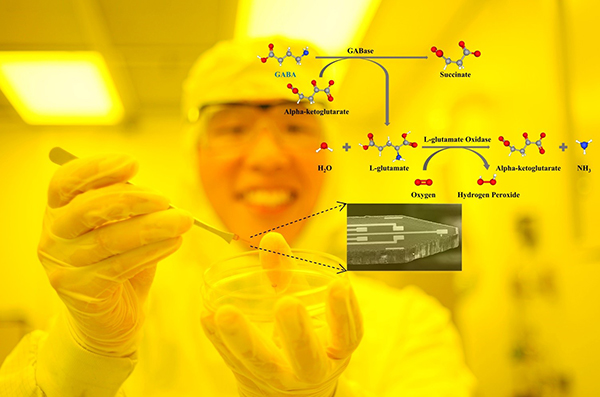UCI Engineers Create Microsensor to Monitor Real-time Brain Activity

Nov. 6, 2023 - UC Irvine engineering researchers have developed a novel micro biosensor that could help neuroscientists investigate and better understand normal brain functions and disorders such as autism, brain injury and stroke.
“This is the first showcase of a dual L-glutamate/GABBA implantable microsensor, which can help transform the field of brain research in many aspects,” said Hung Cao, UCI associate professor of electrical engineering. “This tool is a dream for neuroscientists.”
The tiny device has a shaft with five microelectrodes (50 microns by 100 microns each) at the tip, that can be inserted anywhere into gray matter to successfully detect the two major neurotransmitters that govern excitation and inhibition, namely L-glutamate and gamma-aminobutyric acid (GABA), respectively. These two neurotransmitters govern nearly all processes in the brain, from birth to death.
The research team, led by Cao and his former biomedical engineering doctoral student Sung Sik Chu, validated the sensor in animal models and published their findings in Biosensors and Bioelectronics.
An imbalance of excitation/inhibition ratios are associated with a variety of neurological disorders, making accurate monitoring of these neurotransmitter levels crucial for investigating underlying causes of these conditions.
“We targeted both neurotransmitters simultaneously and in real time so we can actually see the levels and see how any changes in balance can be related to neurological disorders,” said Chu.
With funding from the National Science Foundation, the team has been working on this sensor for the past three years. Chu spent

many hours in the Samueli School’s Integrated Nanosystems Research Facility (INRF) fabricating batches of microprobes, which required advanced equipment in clean rooms and fine-tuning materials to achieve a flexible, biocompatible and highly sensitive sensor.
The dual neurotransmitter sensor probe was validated under various settings for its performance. “Overall, our dual L-glutamate/GABA sensor microprobe has unique features to enable accurate, real-time, and long-term monitoring and it should aid investigations of many brain processes,” said Cao.
He plans to continue fine-tuning the sensor, making it smaller and wireless, and hopes to offer it to others on campus who are researching brain injury, stroke and other neurological disorders.
– Lori Brandt
